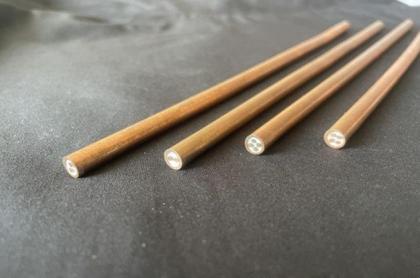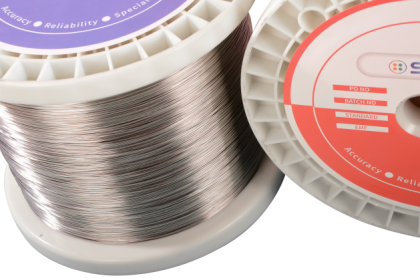NiCrSi-NiCrMg thermocouple is a type of nickel-based alloy temperature measurement material, and it is also a major achievement in the research of base metal thermocouple alloy materials in the world.
1. Advantages
The positive of N-type thermocouple is a nickel-chromium-silicon alloy containing chromium and silicon, and the negative is a nickel-based alloy containing silicon. The main features are as follows:
(1) High temperature oxidation resistance, good long-term stability
In view of the problems of uneven alloy composition and thermal potential drift caused by the preferential oxidation of Cr and Si elements in the nickel-chromium of K-type thermocouple, the content of Si and Cr in the positive of N-type thermocouple is increased, so that the oxidation mode of the nickel-chromium alloy is changed fromthe internal oxidation is transformed into external oxidation, so that the oxidation reaction is only carried out on the surface, and the solute elements Mg and Si are added to the negative electrode, so that the passivation film between the metal and the oxide is denser. And because it forms a diffusion barrier with preferential oxidation, it prevents the "edge erosion" phenomenon from diffusing to the inside and inhibits further oxidation from occurring. In addition, Mn is no longer added to the N-type, and its high-temperature stability and service life are significantly improved compared with the K-type.
(2) Good thermal cycle stability
When K-type thermocouple is used cyclically in the range of 250-550°C, because of the change of its microstructure, it forms a short-range ordered structure, which makes its thermoelectric potential unstable, while N-type thermocouple can eliminate this short-term instability. In the Ni-Cr binary alloy, the Cr content ranges from 5% to 30%, and there is an order-to-disorder transition of the atomic lattice structure. However, within this composition range, there is a very small area, when the Cr content is about 14% to 16%. A nickel-chromium alloy with a Cr content of 14.2% will not be affected by the transition from order-to-disorder in the structure, causing a large change in the thermoelectric potential value. During the heating and cooling process of N-type thermocouple in the range of 250-550°C, the change of the thermoelectric potential does not exceed 10uV.
(3) Regular change of thermoelectric potential
N-type thermocouple suppresses the magnetic transition in the range of 250-550°C, and there is no obvious irregular change of thermoelectric potential. The negative pole of K-type thermocouple undergoes a magnetic transition at about 170°C. The negative electrode alloy composition of N-type thermocouple basically does not contain Mn, Al, Co and other elements, but the Si content is greatly increased, thereby inhibiting the magnetic transition of the new alloy and reducing its magnetic transition temperature below room temperature. The electric potential of N-type changes regularly, and the thermoelectric potential will not deviate from the graduation table due to magnetic changes.
(4) Good radiation resistance
N-type thermocouple has good stability in the environment of neutron radiation because it removes the easily decaying elements Mn and Co. Therefore, N-type thermocouple has better resistance to nuclear radiation than K-type thermocouple.
(5) Good linearity of thermoelectric characteristics
In the range of 400-1300°C, the linearity of the thermoelectric characteristics of N-type thermocouple is better than that of K-type. In the range of 400 to 1300°C, the nonlinear error of N-type thermocouple only accounts for 0.4% of the thermoelectric potential at 1300°C, while the nonlinear error of K-type thermocouple in the same range accounts for 1.75% of the 1300°C. However, N-type thermocouple compared with K-type, the nonlinear error in the low temperature range (-200-400°C) is larger, and the material is harder and difficult to process.
2. Applications
(1) Problems Existing in Measuring Main Steam Temperature with K-Type Thermocouple
A. K-type thermocouple has poor short-term thermal cycle stability in the range of 250-550°C, in the process of heating and cooling, the thermoelectric potential generated at the same temperature is different, and there is a thermoelectric potential-temperature like a hysteresis loop ( E-T) characteristics. And the variation value can reach 2-5°C. The thermal power plant has strict requirements on the temperature of the main steam at 550°C (at the rated parameter value), and the error should be within ±5°C. Obviously K-type thermocouple is not suitable for measuring the main steam temperature.
B. K-type thermocouple has poor high-temperature stability, and they often appear out of tolerance after about one year of use. However, the overhaul cycle of thermal power plant generator sets is generally 2 to 3 years, so K-type thermocouple will appear out of tolerance.
C. The allowable error of K-type thermocouple in terms of temperature is ±0.75%t. When the main steam temperature is 535°C, allowable error is ±4.01%. The temperature measurement system should also consider the errors of secondary instruments and compensation wires. After calculation, the allowable quoted relative error of the main steam temperature measurement system is about ±1.12%. The allowable error is about ±7°C in terms of temperature, which has exceeded the specifiednumerical values, such a main steam temperature measurement system cannot meet production needs.
(2) Advantages
A The thermal cycle stability of N-type thermocouple in the range of 250-550°C is significantly higher than that of K-type thermocouple. Therefore, using N-type thermocouple to measure the main steam temperature can improve the accuracy and reliability of the monitoring system, thus ensuring the firepower safe and economical operation of generating sets.
B The high-temperature stability and service life of N-type thermocouple is doubled compared with K-type thermocouple, and can be synchronized with the overhaul cycle. Therefore, on the basis of the successful application of N-type thermocouple to the main steam temperature measurement, the experimental research of using N-type thermocouple to measure the metal wall temperature of the superheater and cylinder can be carried out, which will ensure the intact rate of the instrument and reduce the failure rate of the instrument.
C It is feasible to replace some thermocouple with N-type thermocouple, which not only greatly simplifies the types of temperature measuring elements and instruments, but also brings great convenience and economic benefits to the production, use and management of temperature measuring elements, sensors and instruments.






 IPv6 network supported
IPv6 network supported